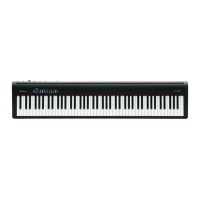MIDI Implementation
25
70121: Auto Wah
Cyclically controls a lter to create cyclic change in timbre.
No Parameter Value Description
1 Filter Type 0–1 Lpf, Bpf
Type of lter
Lpf: The wah eect will be
applied over a wide frequency
range.
Bpf: The wah eect will be
applied over a narrow
frequency range.
2 Manual #2 0–127 0 –127
Adjusts the center frequency
at which the eect is applied.
3 Peak 0–127 0 –127
Adjusts the amount of the
wah eect that will occur in
the range of the center
frequency.
Set a higher value for Q to
narrow the range to be
aected.
4 Sens 0–127 0 –127
Adjusts the sensitivity with
which the lter is controlled.
5 Polarity 0–1 Up, Down
Sets the direction in which
the frequency will change
when the auto-wah lter is
modulated.
Up: The lter will change
toward a higher frequency.
Down: The lter will change
toward a lower frequency.
6 Rate Mode 0–1 Hz, note
When this is set to “note,” the
eect is synchronized with
the tempo.
7 Rate #1 1–127
0.05–10.00
Hz
Frequency of modulation (Hz)
8 Rate 0–21 note
Frequency of modulation
(note)
9 Depth 0–127 0–127 Depth of modulation
10 Phase 0–90 0–180 deg
Adjusts the degree of phase
shift of the left and right
sounds when the wah eect is
applied.
11 Low Gain 0–30 -15–+15 dB Gain of the low range
12 High Gain 0–30 -15–+15 dB Gain of the high range
13 Level 0–127 0–127 Output Level
70103: Humanizer
Adds a vowel character to the sound, making it similar to a human voice.
No Parameter Value Description
1 Drive Sw 0–1 O, On Turns Drive on/o.
2 Drive #2 0–127 0–127
Degree of distortion
Also changes the volume.
3 Vowel1 0–4 a, e, i, o, u
Selects the vowel.
4 Vowel2 0–4 a, e, i, o, u
5 Rate Mode 0–1 Hz, note
When this is set to “note,” the
eect is synchronized with
the tempo.
6 Rate 1–127
0.05–10.00
Hz
Frequency at which the two
vowels switch (Hz)
7 Rate #1 0–21 note
Frequency at which the two
vowels switch (note)
8 Depth 0–127 0–127 Eect depth
9
Input Sync
Sw
0–1 O, On
Determines whether the LFO
for switching the vowels is
reset by the input signal (ON)
or not (OFF).
10
Input Sync
Threshold
0–127 0 –127
Volume level at which reset is
applied
No Parameter Value Description
11 Manual 0–100 0–100
Point at which Vowel 1/2
switch
49 or less: Vowel 1 will have a
longer duration.
50: Vowel 1 and 2 will be of
equal duration.
51 or more: Vowel 2 will have
a longer duration.
12 Low Gain 0–30 -15–+15 dB
Gain of the low frequency
range
13 High Gain 0–30 -15–+15 dB
Gain of the high frequency
range
14 Pan 0–127 L64–63R Stereo location of the output
15 Level 0 –127 0 –127 Output level
7012b: Ring Modulator
This is an eect that applies amplitude modulation (AM) to the input signal,
producing bell-like sounds. You can also change the modulation frequency in
response to changes in the volume of the sound sent into the eect.
No Parameter Value Description
1 Frequency #1 0 –127 0–127
Adjusts the frequency at
which modulation is applied.
2 Sens 0–127 0 –127
Adjusts the amount of
frequency modulation
applied.
3 Polarity 0–1 Up, Down
Determines whether the
frequency modulation moves
towards higher frequencies
(Up) or lower frequencies
(Down).
4 Low Gain 0–30 -15–+15 dB
Gain of the low frequency
range
5 High Gain 0–30 -15–+15 dB
Gain of the high frequency
range
6 Balance #2 0–100
D100:0W–
D0:100W
Volume balance between the
direct sound (D) and the
eect sound (W)
7 Level 0–127 0–127 Output level
70125: Tremolo
Cyclically modulates the volume to add tremolo eect to the sound.
No Parameter Value Description
1 Mod Wave 0–4
Tri, Sqr, Sin,
Saw1, Saw2
Modulation Wave
Tri: Triangle wave
Sqr: Square wave
Sin: Sine wave
Saw1/2: Sawtooth wave
2 Rate Mode 0–1 Hz, note
When this is set to “note,” the
eect is synchronized with
the tempo.
3 Rate #1 1–127
0.05–10.00
Hz
Frequency of the change (Hz)
4 Rate 0–21 note
Frequency of the change
(note)
5 Depth #2 0–127 0–127
Depth to which the eect is
applied
6 Low Gain 0–30 -15–+15 dB Gain of the low range
7 High Gain 0–30 -15–+15 dB Gain of the high range
8 Level 0–127 0–127 Output Level

